KTM 250 SX, 150 SX Manual
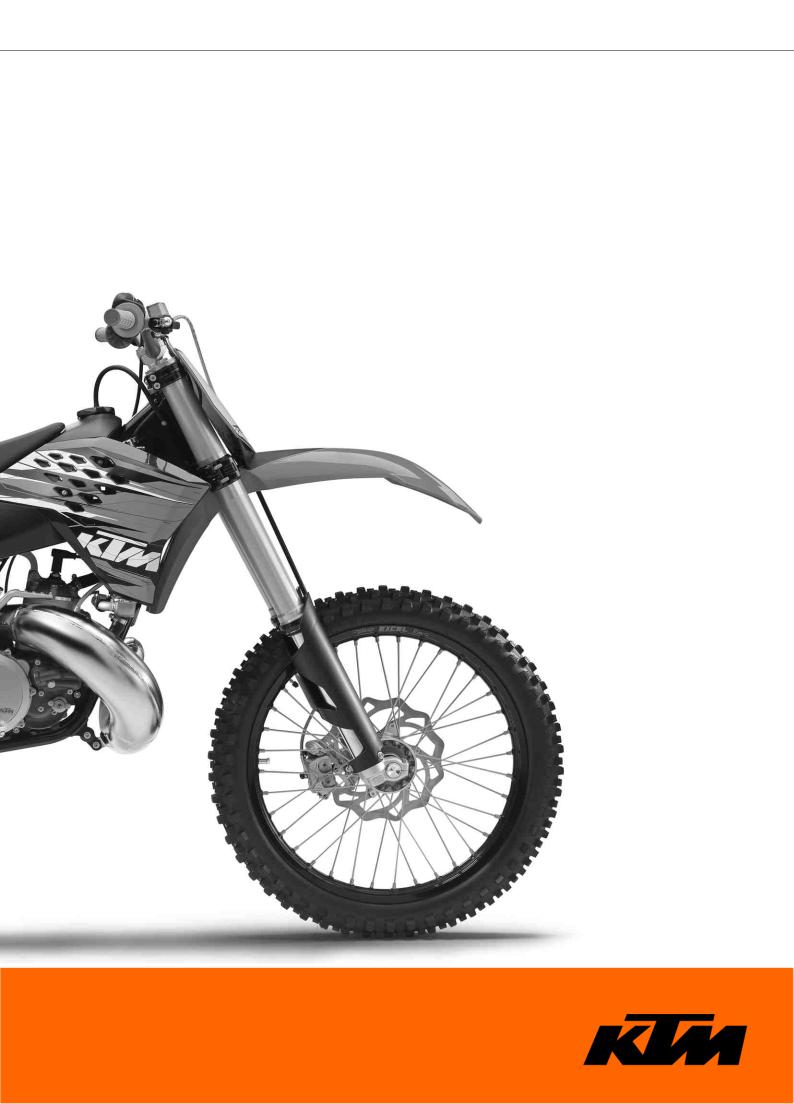
OWNER'S MANUAL 2010
125 SX
150 SX
250 SX
Art. no. 3211480en
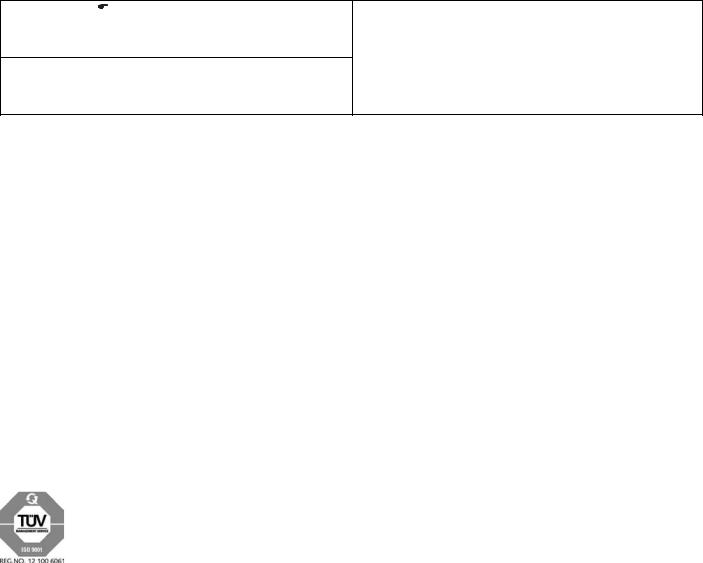
DEAR KTM CUSTOMER |
1 |
Congratulations on your decision to purchase a KTM motorcycle. You are now the owner of a state-of-the-art sports motorcycle that will give you enormous pleasure if you service and maintain it accordingly.
We wish you great pleasure riding the vehicle!
Enter the serial numbers of your vehicle below.
Chassis number ( p. 9) |
Dealer's stamp |
Engine number ( p. 9)
p. 9)
The owner's manual corresponded to the latest state of this series at the time of printing. Slight deviations resulting from continuing development and design can, however, not be completely excluded.
All specifications are non-binding. KTM Sportmotorcycle AG specifically reserves the right to modify or delete technical specifications, prices, colors, forms, materials, services, designs, equipment, etc., without prior notice and without specifying reasons, to adapt these to local conditions, as well as to stop production of a particular model without prior notice. KTM accepts no liability for delivery options, deviations from illustrations and descriptions, as well as misprints and other errors. The models portrayed partly contain special equipment that does not belong to the regular scope of delivery.
© 2009 by KTM-Sportmotorcycle AG, Mattighofen Austria All rights reserved
Reproduction, even in part, is permitted only with the express written permission of the copyright owner.
ISO 9001(12 100 6061)
According to the international quality management standard ISO 9001, KTM uses quality assurance processes that lead to the maximum possible quality of the products.
Issued by: TÜV Management Service
KTM-Sportmotorcycle AG
5230 Mattighofen, Austria
TABLE OF CONTENTS |
2 |
MEANS OF REPRESENTATION ............................................ |
4 |
IMPORTANT INFORMATION ................................................ |
5 |
VIEW OF VEHICLE............................................................... |
7 |
View of the vehicle from the left front (example)................. |
7 |
View of the vehicle from the right rear (example) ................ |
8 |
LOCATION OF SERIAL NUMBERS ........................................ |
9 |
Chassis number............................................................... |
9 |
Type label....................................................................... |
9 |
Engine number................................................................ |
9 |
Fork part number............................................................. |
9 |
Shock absorber part number............................................. |
9 |
CONTROLS ....................................................................... |
10 |
Clutch lever .................................................................. |
10 |
Hand brake lever ........................................................... |
10 |
Short circuit button ....................................................... |
10 |
Throttle grip.................................................................. |
10 |
Fuel tap........................................................................ |
11 |
Opening the filler cap .................................................... |
11 |
Closing the filler cap...................................................... |
11 |
Choke........................................................................... |
11 |
Shift lever..................................................................... |
12 |
Kickstarter.................................................................... |
12 |
Foot brake lever............................................................. |
12 |
Plug-in stand ................................................................ |
13 |
GENERAL TIPS AND HINTS ON PUTTING INTO |
|
OPERATION...................................................................... |
14 |
Advice on first use......................................................... |
14 |
Running in the engine.................................................... |
15 |
Preparing the vehicle for difficult operating conditions ...... |
15 |
Preparations for riding on dry sand .................................. |
15 |
Preparations for riding on wet sand ................................. |
16 |
Preparations for riding on wet and muddy surfaces ........... |
17 |
Preparations for riding at high temperatures and riding |
|
slowly........................................................................... |
18 |
Preparations for riding at low temperatures and in snow .... |
18 |
RIDING INSTRUCTIONS .................................................... |
19 |
Checks before putting into operation ............................... |
19 |
Starting ........................................................................ |
19 |
Starting up ................................................................... |
20 |
Shifting, riding.............................................................. |
20 |
Braking ........................................................................ |
20 |
Stopping, parking .......................................................... |
21 |
Refueling...................................................................... |
21 |
SERVICE SCHEDULE......................................................... |
23 |
Important maintenance work that must be done in an |
|
authorized KTM workshop .............................................. |
23 |
Important maintenance work to be carried out by an |
|
authorized KTM workshop (as additional order)................. |
24 |
Important checks and maintenance work to be carried |
|
out by the rider ............................................................. |
24 |
MAINTENANCE WORK ON CHASSIS AND ENGINE.............. |
26 |
Jacking up the motorcycle .............................................. |
26 |
Removing the motorcycle from the work stand.................. |
26 |
Checking the basic chassis setting with the rider's |
|
weight .......................................................................... |
26 |
Compression damping of shock absorber.......................... |
26 |
Adjusting the high-speed compression damping of the |
|
shock absorber .............................................................. |
26 |
Adjusting the low-speed compression damping of the |
|
shock absorber .............................................................. |
27 |
Adjusting the rebound damping of the shock absorber....... |
28 |
Measuring the sag of the unloaded rear wheel .................. |
28 |
Checking the static sag of the shock absorber .................. |
29 |
Checking the riding sag of the shock absorber .................. |
29 |
Adjusting the spring preload of the shock absorber x...... |
29 |
Adjusting the riding sag x............................................. |
30 |
Removing the shock absorber x..................................... |
30 |
Installing the shock absorber x..................................... |
31 |
Checking the basic setting of the fork.............................. |
31 |
Adjusting the compression damping of the fork ................ |
31 |
Adjusting the rebound damping of the fork....................... |
32 |
Bleeding the fork legs .................................................... |
32 |
Cleaning the dust boots of the fork legs ........................... |
32 |
Loosening the fork protection.......................................... |
33 |
Positioning the fork protection ........................................ |
33 |
Checking the play of the steering head bearing................. |
33 |
Adjusting the play of the steering head bearing x............ |
34 |
Removing the fork legs x.............................................. |
34 |
Installing the fork legs x............................................... |
35 |
Removing the fork protector x....................................... |
35 |
Installing the fork protector x....................................... |
35 |
Removing the lower triple clamp x................................ |
36 |
Installing the lower triple clamp x................................. |
36 |
Greasing the steering head bearing x............................. |
37 |
Removing the front fender .............................................. |
37 |
Installing the front fender............................................... |
37 |
Removing the start number plate .................................... |
37 |
Installing the start number plate ..................................... |
38 |
Handlebar position ........................................................ |
38 |
Adjusting the handlebar position x................................ |
38 |
Checking the play in the throttle cable............................. |
39 |
Adjusting the play in the throttle cable x....................... |
39 |
Checking the chain for dirt ............................................. |
39 |
Cleaning the chain......................................................... |
39 |
Checking the chain tension ............................................ |
40 |
Checking the rear sprocket/engine sprocket for wear ......... |
40 |
Checking chain wear...................................................... |
40 |
Adjusting the chain tension ............................................ |
41 |
Adjusting the chain guide x.......................................... |
42 |
Checking the brake discs................................................ |
42 |
Checking the free travel of the hand brake lever ............... |
43 |
Adjusting the basic position of the hand brake lever.......... |
43 |
Checking the front brake fluid level ................................. |
43 |
Adding front brake fluid x............................................ |
44 |
Checking the front brake linings...................................... |
44 |
Removing the front brake linings x................................ |
45 |
Installing the front brake linings x................................. |
45 |
Changing the front brake linings x................................. |
46 |
Checking the free play of the foot brake lever ................... |
46 |
Adjusting the basic position of the foot brake lever x...... |
47 |
Checking the rear brake fluid level .................................. |
47 |
Adding rear brake fluid x.............................................. |
48 |
Checking the rear brake linings ....................................... |
48 |
Removing the rear brake linings x................................. |
49 |
Installing the rear brake linings x.................................. |
49 |
Changing the rear brake linings x.................................. |
50 |
Removing the front wheel x.......................................... |
50 |
Installing the front wheel x........................................... |
51 |
Removing the rear wheel x........................................... |
52 |
Installing the rear wheel x............................................ |
52 |
Checking the tire condition............................................. |
53 |
Checking the tire air pressure ......................................... |
54 |
Checking the spoke tension ............................................ |
54 |
TABLE OF CONTENTS |
3 |
Ignition curve plug connection ........................................ |
54 |
Changing the ignition curve ............................................ |
55 |
Engine characteristic - auxiliary spring (250 SX)............... |
55 |
Engine characteristic - adjusting the auxiliary spring x |
|
(250 SX) ...................................................................... |
55 |
Removing the seat ......................................................... |
56 |
Mounting the seat ......................................................... |
56 |
Removing the fuel tank x............................................. |
56 |
Installing the fuel tank x.............................................. |
57 |
Cooling system .............................................................. |
58 |
Checking the antifreeze and coolant level ........................ |
58 |
Checking the coolant level.............................................. |
59 |
Draining the coolant x.................................................. |
59 |
Refilling with coolant x................................................ |
60 |
Removing the main silencer............................................ |
61 |
Installing the main silencer ............................................ |
61 |
Glass fiber yarn filling of main silencer ............................ |
61 |
Changing the glass fiber yarn filling of the main |
|
silencer x................................................................... |
61 |
Removing the glass fiber yarn filling of the main |
|
silencer x................................................................... |
62 |
Installing the glass fiber yarn filling of the main |
|
silencer x................................................................... |
62 |
Removing the air filter box lid......................................... |
62 |
Installing the air filter box lid.......................................... |
62 |
Removing the air filter x............................................... |
63 |
Installing the air filter x............................................... |
63 |
Cleaning the air filter x................................................ |
63 |
Adjusting the basic position of the clutch lever................. |
64 |
Checking the fluid level of the hydraulic clutch ................ |
64 |
Changing the hydraulic clutch fluid x............................ |
65 |
Checking the basic position of the shift lever.................... |
66 |
Adjusting the basic position of the shift lever x.............. |
66 |
Carburetor .................................................................... |
66 |
Carburetor - adjusting the idle speed x.......................... |
67 |
Emptying the carburetor float chamber x....................... |
68 |
Checking the gear oil level.............................................. |
68 |
Changing the gear oil x................................................ |
69 |
Draining the gear oil x................................................. |
69 |
Refilling with gear oil x................................................ |
70 |
Adding gear oil x......................................................... |
70 |
TROUBLESHOOTING......................................................... |
72 |
CLEANING........................................................................ |
74 |
Cleaning the motorcycle ................................................. |
74 |
STORAGE ......................................................................... |
75 |
Storage......................................................................... |
75 |
Putting into operation after storage ................................. |
75 |
TECHNICAL DATA - ENGINE.............................................. |
76 |
125 SX......................................................................... |
76 |
150 SX......................................................................... |
76 |
250 SX......................................................................... |
77 |
Capacity - gear oil.......................................................... |
77 |
Capacity - coolant.......................................................... |
77 |
TECHNICAL DATA - ENGINE TIGHTENING TORQUES.......... |
78 |
125 SX, 150 SX............................................................ |
78 |
250 SX......................................................................... |
78 |
TECHNICAL DATA - CARBURETOR..................................... |
80 |
125 SX......................................................................... |
80 |
Carburetor - basic setting for sandy surfaces (125 SX) ...... |
80 |
Carburetor configuration (125 SX)................................... |
81 |
150 SX......................................................................... |
82 |
Carburetor - basic setting for sandy surfaces (150 SX) ...... |
82 |
|
Carburetor configuration (150 SX)................................... |
83 |
|
250 |
SX......................................................................... |
84 |
Carburetor - basic setting for sandy surfaces (250 SX) ...... |
84 |
|
Carburetor configuration (250 SX)................................... |
85 |
|
TECHNICAL DATA - CHASSIS ............................................ |
86 |
|
Tires |
............................................................................ |
86 |
Capacity - fuel............................................................... |
86 |
|
TECHNICAL DATA - FORK.................................................. |
87 |
|
125 |
SX, 150 SX............................................................ |
87 |
250 |
SX......................................................................... |
87 |
TECHNICAL DATA - SHOCK ABSORBER ............................. |
88 |
|
125 |
SX, 150 SX............................................................ |
88 |
250 |
SX......................................................................... |
88 |
TECHNICAL DATA - TIGHTENING TORQUES FOR |
|
|
CHASSIS .......................................................................... |
90 |
|
WIRING DIAGRAM ............................................................ |
92 |
|
Wiring diagram.............................................................. |
92 |
|
SUBSTANCES................................................................... |
94 |
|
AUXILIARY SUBSTANCES.................................................. |
96 |
|
STANDARDS..................................................................... |
98 |
|
INDEX .............................................................................. |
|
99 |
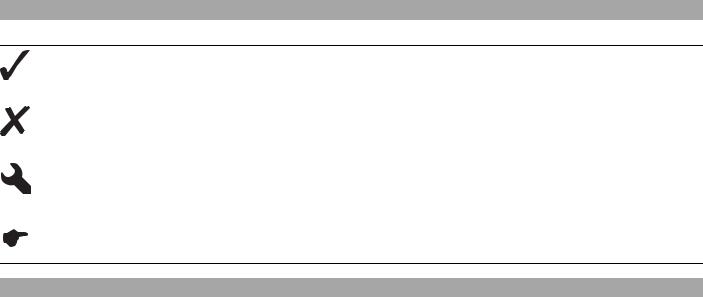
MEANS OF REPRESENTATION |
4 |
Symbols used
The symbols used are explained below.
Indicates an expected reaction (e.g. of a work step or a function).
Indicates an unexpected reaction (e.g. of a work step or a function).
All work marked with this symbol requires specialist knowledge and technical understanding. In the interest of your own safety, have these jobs done in an authorized KTM workshop! There, your motorcycle will be serviced optimally by specially trained experts using the specialist tools required.
Identifies a page reference (more information is provided on the specified page).
Formats used
The typographical and other formats used are explained below.
Specific name |
Identifies a specific name. |
Name® |
Identifies a protected name. |
Brand™ |
Identifies a brand available on the open market. |
|
|
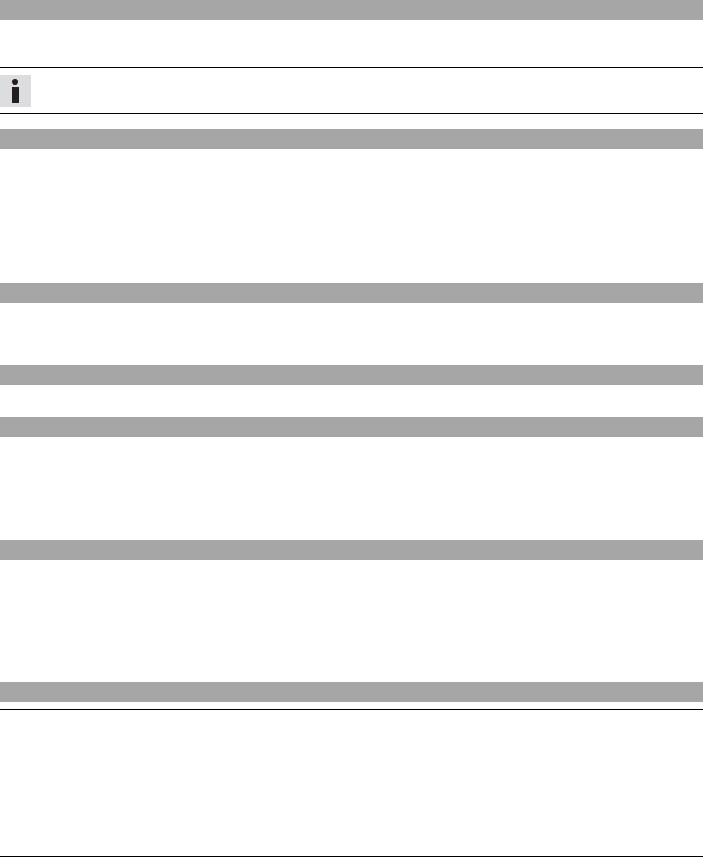
IMPORTANT INFORMATION |
5 |
Use definition
KTM sport motorcycles are designed and built to withstand the normal stresses and strains of competitive use. The motorcycles comply with currently valid regulations and categories of the top international motorsport organizations.
Info
The motorcycle must be used only in closed off areas remote from public road traffic.
Maintenance
A prerequisite for perfect operation and prevention of wear is that the engine and chassis maintenance and adjustment work described in the owner's manual are properly carried out. Poor adjustment and tuning of the engine and chassis can lead to damage and breakage of components.
Using the motorcycle in difficult conditions such as on sand or very muddy or wet terrain can lead to above-average wear of components such as the transmission train or the brakes. For this reason, it may be necessary to service or replace worn parts before the limit specified in the service schedule is reached.
Pay careful attention to the prescribed running-in period, inspection and maintenance intervals. If you observe these exactly, you will ensure a much longer service life for your motorcycle.
Warranty
The work prescribed in the service schedule must be carried out in an authorized KTM workshop only and confirmed in the customer's service record, since otherwise no warranty claims will be honored. No warranty claims can be considered for damage resulting from manipulations and/or alterations to the vehicle.
Fuel, oils, etc.
You should use the fuels, oils and greases according to specifications as listed in the owner's manual.
Spare parts, accessories
For your own safety, only use spare parts and accessory products that have been approved and/or recommended by KTM and have them installed by an authorized KTM workshop. KTM accepts no liability for other products and any resulting damage or loss. Certain spare parts and accessories are specified in parentheses in the descriptions. Your KTM dealer will be glad to advise you.
You will find the current KTM PowerParts for your vehicle on the KTM website.
International KTM Website: http://www.ktm.com
Work rules
Special tools are needed for certain tasks. They are not included with the vehicle but can be ordered under the number in parentheses. E.g.: bearing puller (15112017000)
When the vehicle is assembled, non-reusable parts (e.g., self-locking screws and nuts, gaskets, seal rings, O-rings, splints, lock washers) must be replaced with new parts.
Where thread lockers are used on screw connections (e.g., Loctite®), follow the instructions for use from the manufacturer. After disassembly, clean the parts that are to be reused and check them for damage and wear. Replace damaged or worn parts. After you complete the repair or maintenance work, check the roadworthiness of the vehicle.
Transport
Note
Danger of damage The parked vehicle can roll away or fall over.
–Always place the vehicle on a firm and even surface.
Note
Fire hazard Some vehicle components become very hot when the vehicle is operated.
–Do not park the vehicle near flammable or explosive substances. Do not place objects on the vehicle while it is still warm from being run. Always let the vehicle cool first.
–Switch off the engine.
–Turn handle of the fuel tap to the OFF position. (Figure B00003-10 p. 11)
p. 11)
–Use straps or other suitable devices to secure the motorcycle against accidents or falling over.
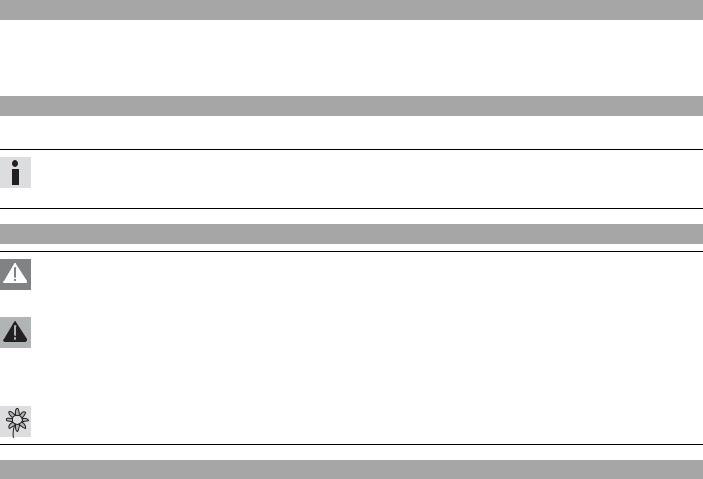
IMPORTANT INFORMATION |
6 |
Environment
Motorcycling is a wonderful sport and we naturally hope that you can enjoy it to the full. However, it is a potential problem for the environment and can lead to conflicts with other persons. But if you use your motorcycle responsibly, you can ensure that such problems and conflicts do not have to occur. To protect the future of motorcycle sport, make sure that you use your motorcycle legally, display environmental consciousness, and respect the rights of others.
Notes/warnings
Pay close attention to the notes/warnings.
Info
Various information and warning labels are affixed to the vehicle. Do not remove information/warning labels. If they are missing, you or others may not recognize potential hazards and may therefore be injured.
Grades of risks
Danger
Identifies a danger that will immediately and invariably lead to fatal or serious permanent injury if the appropriate measures are not taken.
Warning
Identifies a danger that is likely to lead to fatal or serious injury if the appropriate measures are not taken.
Note
Identifies a danger that will lead to considerable machine and material damage if the appropriate measures are not taken.
Warning
Identifies a danger that will lead to environmental damage if the appropriate measures are not taken.
Owner's manual
–It is important that you read this owner's manual carefully and completely before making your first trip. It contains information and tips that will assist you in operating and handling your motorcycle properly. Only then will you learn how to adjust the motorcycle to your own requirements and how to protect yourself from injury. The owner's manual also contains important information on servicing the motorcycle.
–The owner's manual is an important component of the motorcycle and should be handed over to the new owner if the vehicle is sold.
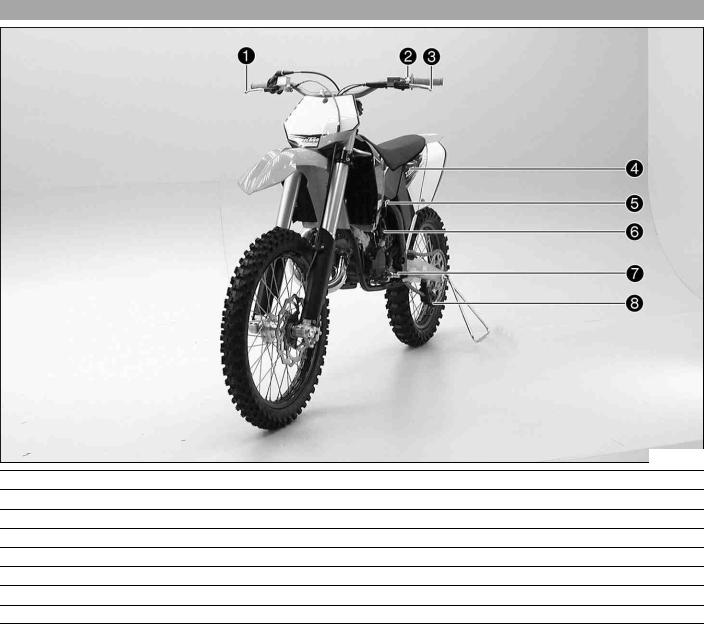
VIEW OF VEHICLE |
7 |
View3.1 of the vehicle from the left front (example)
B00010-10
1Hand brake lever
2Short circuit button
3Clutch lever
4Air filter box lid
5Fuel tap
6Choke button
7Shift lever
8Chain guide
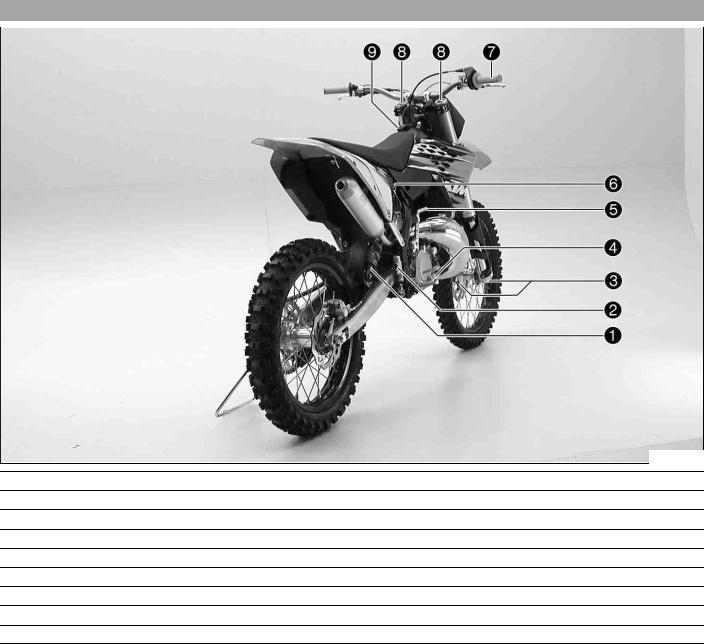
VIEW OF VEHICLE |
8 |
View3.2 of the vehicle from the right rear (example)
B00014-10
1Shock absorber rebound adjustment
2Level viewer for brake fluid, rear
3Fork rebound adjustment
4Foot brake lever
5Kickstarter
6Shock absorber compression adjustment
7Throttle grip
8Fork compression adjustment
9Filler cap
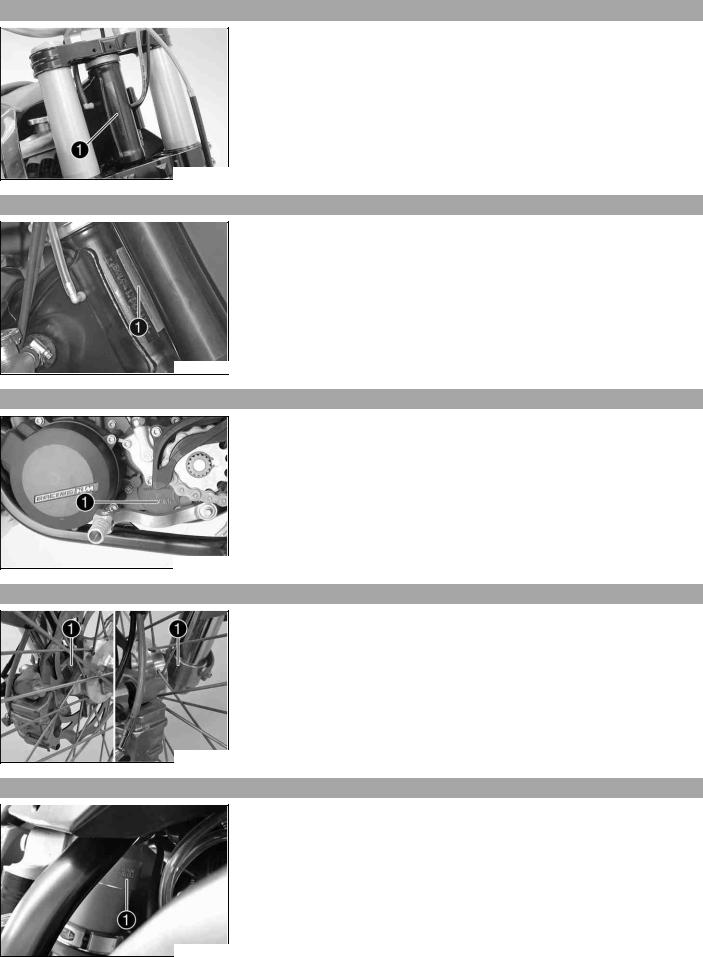
LOCATION OF SERIAL NUMBERS |
9 |
Chassis4.1 number
The chassis number is stamped on the right side of the steering head.
B00015-10
Type4.2 label
The type label is fixed to the front of the steering head.
400284-10
Engine4.3 number
The engine number is stamped on the left side of the engine under the engine sprocket.
B00016-10
Fork4.4 part number
The fork part number is stamped on the inner side of the fork stub.
500082-10
Shock4.5 absorber part number
The shock absorber part number is stamped on the top of the shock absorber above the adjusting ring on the engine side.
500083-10
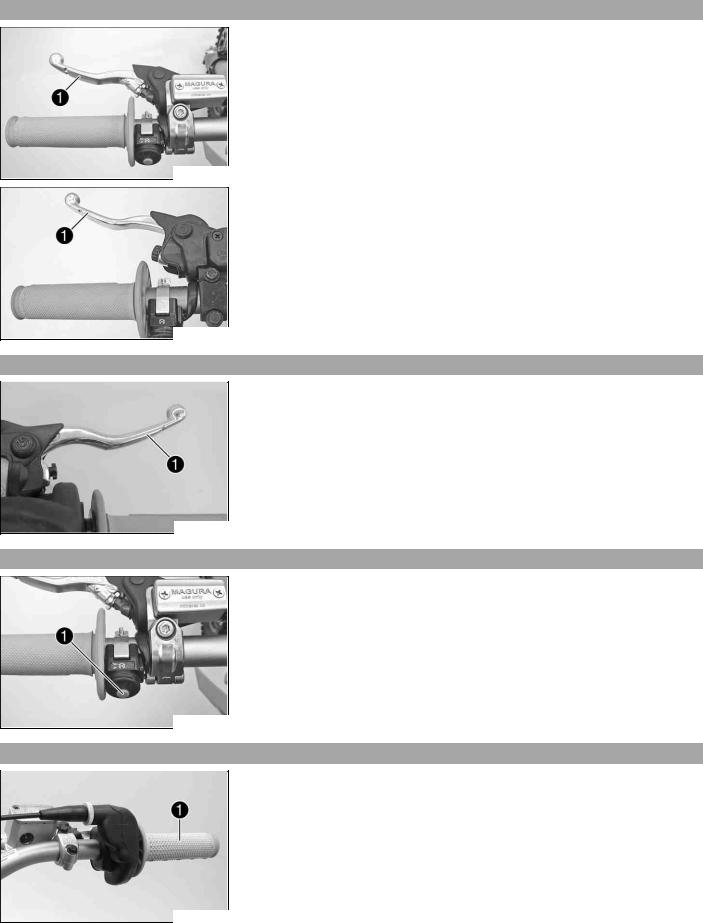
CONTROLS |
10 |
Clutch5.1 lever
(125 SX, 150 SX)
The clutch lever is fitted on the left side of the handlebar. The clutch is hydraulically operated and self-adjusting.
B00001-10
(250 SX)
The clutch lever is fitted on the left side of the handlebar. The clutch is hydraulically operated and self-adjusting.
B00009-10
Hand5.2 brake lever
Hand brake lever is located on the right side of the handlebar.
The hand brake lever is used to activate the front brake.
400196-10
Short5.3 circuit button
Short circuit button is fitted on the left side of the handlebar.
Possible states
•Short circuit button  in basic position – In this position, the ignition circuit is closed, and the engine can be started.
in basic position – In this position, the ignition circuit is closed, and the engine can be started.
•Short circuit button  pressed – In this position, the ignition circuit is interrupted, a running engine stops, and a non-running engine will not start.
pressed – In this position, the ignition circuit is interrupted, a running engine stops, and a non-running engine will not start.
B00002-10
Throttle5.4 grip
Throttle grip is fitted on the right side of the handlebar.
B00060-10

CONTROLS |
11 |
Fuel5.5 tap
The fuel tap is on the left side of the fuel tank.
With tap handle on the fuel tap, you can open or close the supply of fuel to the carburetor.
Possible states
•Fuel supply closed OFF – No fuel can flow from the tank to the carburetor.
•Fuel supply open ON – Fuel can flow from the tank to the carburetor. The fuel tank empties completely.
B00003-10
Opening5.6 the filler cap
–Press release button , turn the filler cap counterclockwise and lift it free.
400199-10
Closing5.7 the filler cap
–Replace the filler cap and turn clockwise until the release button locks in place.
Info
Run the fuel tank breather hose without kinks.
400199-11
Choke5.8
B00004-10
The choke is fitted on the left side of the carburetor.
Activating the choke function frees an opening through which the engine can draw extra fuel. This gives a richer fuel-air mixture, which is needed for a cold start.
Info
If the engine is warm, the choke function must be deactivated.
Possible states
•Choke function activated – The choke lever is pulled out to the stop.
•Choke function deactivated – The choke lever is pushed in to the stop.

CONTROLS |
12 |
Shift5.9 lever
Shift lever is mounted on the left side of the engine.
B00005-10
(125 SX, 150 SX)
The gear positions can be seen in the photograph.
The neutral or idle position is between the first and second gears.
B00005-12
(250 SX)
The gear positions can be seen in the photograph.
The neutral or idle position is between the first and second gears.
B00005-11
Kickstarter5.10
The kickstarter is fitted on the right side of the engine. The top part can be swiveled.
B00006-10
Foot5.11 brake lever
Foot brake lever is located in front of the right footrest.
The foot brake lever is used to activate the rear brake.
B00007-10

CONTROLS |
13 |
Plug5.12 -in stand
400203-10
Note
Danger of damage The parked vehicle can roll away or fall over.
–Always place the vehicle on a firm and even surface.
To park the motorcycle, insert plug-in stand into the left side of the wheel spindle.
Info
Remove the plug-in stand before riding.
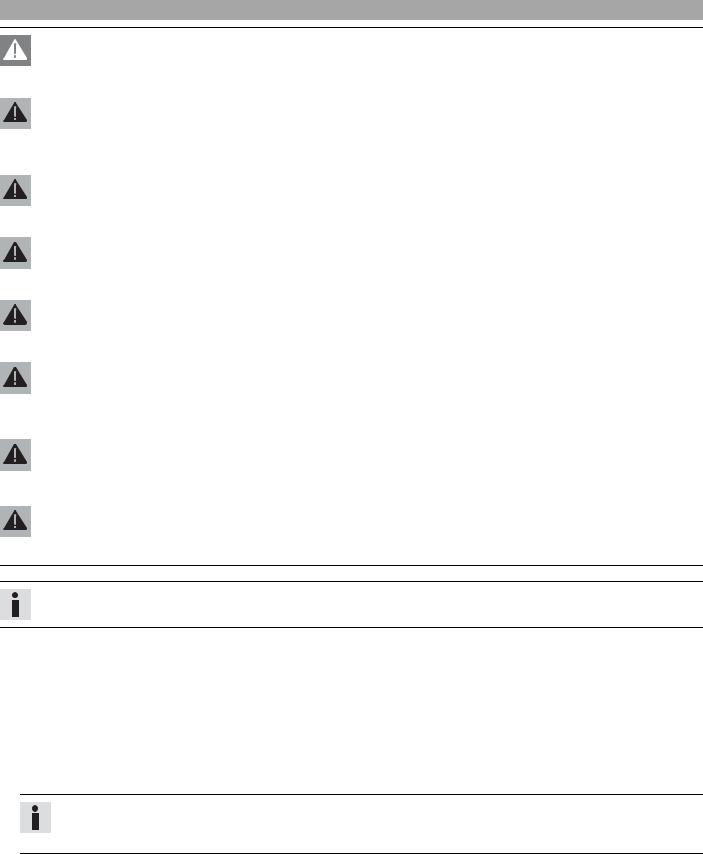
GENERAL TIPS AND HINTS ON PUTTING INTO OPERATION |
14 |
Advice6.1 on first use
Danger
Danger of accidents Danger arising from the rider's judgement being impaired.
–Do not use the vehicle if you are inexperienced or if you have consumed alcohol or drugs.
Warning
Risk of injury Missing or poor protective clothing present an increased safety risk.
–Wear protective clothing (helmet, boots, gloves, pants and jacket with protectors) every time you ride the vehicle. Always wear protective clothing, which must be undamaged and meet legal requirements.
Warning
Danger of crashing Poor vehicle handling due to different tire tread patterns on front and rear wheels.
–The front and rear wheels must be fitted with tires with similar tread patterns to prevent loss of control over the vehicle.
Warning
Danger of accidents Critical handling characteristic due to inappropriate riding style.
–Adapt your riding speed to the road conditoins and your riding ability.
Warning
Danger of accidents Accident risk caused by presence of a passenger.
–Your vehicle is not designed to carry passengers. Do not ride with a passenger.
Warning
Danger of accidents Failure of brake system.
–If the foot brake lever is not released, the brake linings drag permanently. The rear brake can fail due to overheating. Take your foot off the foot brake lever if you do not want to brake.
Warning
Danger of accidents Unstable riding behavior.
–Do not exceed the maximum permissible weight and axle loads.
Warning
Risk of misappropriation Usage by unauthorized persons.
–Never leave the vehicle while the engine is running. Secure the vehicle against use by unauthorized persons.
Info
When using your motorcycle, remember that others may feel disturbed by excessive noise.
–Make sure that the pre-delivery inspection work has been carried out by an authorized KTM workshop.  You receive a delivery certificate and the service record at vehicle handover.
You receive a delivery certificate and the service record at vehicle handover.
–Before your first trip, read the entire operating instructions carefully.
–Get to know the controls.
–Adjust the basic position of the clutch lever. ( p. 64)
p. 64)
–Adjust the basic position of the hand brake lever. ( p. 43)
p. 43)
–Adjust the basic position of the foot brake lever. x( p. 47)
p. 47)
–Become accustomed to the handling of the motorcycle on suitable terrain.
Info
Your motorcycle is not authorized for riding on public roads.
Offroad, you should be accompanied by another person on another machine so that you can help each other.
–Try also to ride as slowly as possible and in a standing position to get a better feeling for the vehicle.
–Do not make any offroad trips that over-stress your ability and experience.
–Hold the handlebar firmly with both hands and keep your feet on the footrests when riding.
–Do not transport luggage.
–Do not exceed the overall maximum permitted weight and the axle loads.
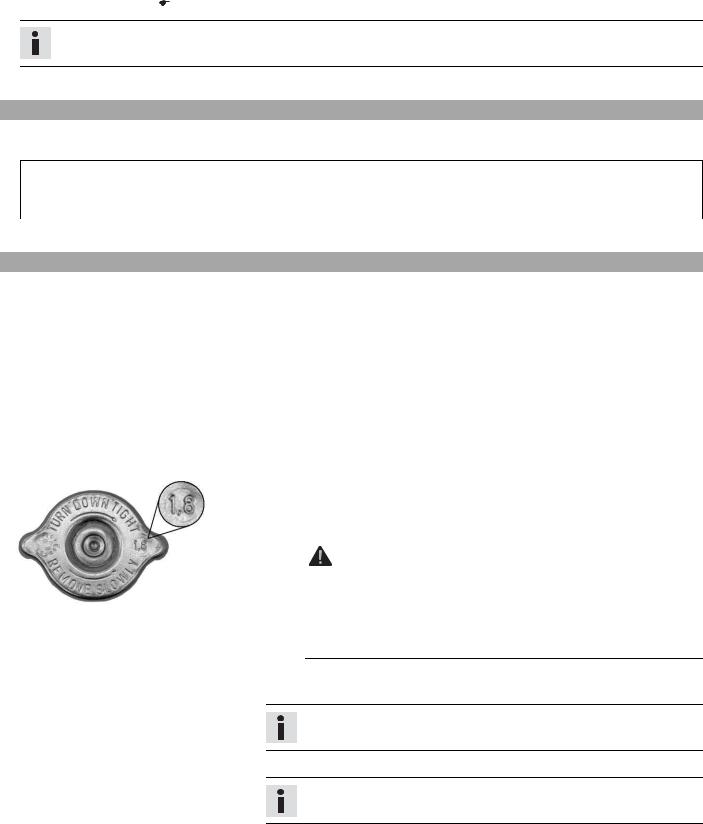
GENERAL TIPS AND HINTS ON PUTTING INTO OPERATION |
15 |
|||
|
Guideline |
|
|
|
|
|
|
|
|
|
Maximum permissible overall weight |
335 kg (739 lb.) |
|
|
|
|
|
|
|
|
Maximum permissible front axle load |
145 kg (320 lb.) |
|
|
|
|
|
|
|
|
Maximum permissible rear axle load |
190 kg (419 lb.) |
|
|
|
|
|
|
|
– Check the spoke tension. ( p. 54) |
|
|
|
|
Info
The spoke tension must be checked after riding the motorcycle for one half hour.
–Run the engine in.
Running6.2 in the engine
–During the running-in phase, do not exceed the specified engine performance. Guideline
Maximum engine performance
During the first 3 service hours |
< 70 % |
|
|
During the first 5 service hours |
< 100 % |
|
|
– Avoid fully opening the throttle!
Preparing6.3 the vehicle for difficult operating conditions
–The use of motorcycles under difficult operating conditions can lead to above-average wear of components such as the drive train or brakes. For this reason, it may be necessary to service or replace worn parts before the limit specified in the service schedule is reached.
Difficult operating conditions are:
–Riding on dry sand. ( p. 15)
p. 15)
–Riding on wet sand. ( p. 16)
p. 16)
–Riding on wet and muddy surfaces. ( p. 17)
p. 17)
–Riding at high temperatures and riding slowly. ( p. 18)
p. 18)
–Riding at low temperatures and in snow. ( p. 18)
p. 18)
Preparations6.4 |
for riding on dry sand |
|
|
|
|
|
|
|
|
|
– Check the radiator cap. |
|
|||
|
|
|
|
||||
|
|
|
|
|
|
|
|
|
|
|
|
Value on radiator cap |
1.8 bar (26 psi) |
||
|
|
|
|
|
|
|
|
|
|
|
|
» If the value displayed does not meet specifications: |
|||
|
|
|
|
|
|
|
|
|
|
|
|
|
|
Warning |
|
|
|
|
|
|
|
|
|
|
|
|
|
|
|
Danger of scalding During motorcycle operation, the coolant gets |
|
|
|
|
|
|
|
very hot and is under pressure. |
|
|
|
|
|
|
|
– Do not remove the radiator cap, radiator hoses or other cooling |
|
|
|
600872-10 |
|
|
|
system components when the engine is hot. Allow the engine |
|
|
|
|
|
|
|
and cooling system to cool down. In case of scalding, rinse |
|
|
|
|
|
|
|
immediately with lukewarm water. |
|
– Change the radiator cap.
– Seal the air filter box. x
Tip
Seal the air filter box at the edges to prevent dirt from entering.
–Clean the air filter. x( p. 63)
p. 63)
Info
Check the air filter approx. every 30 minutes.
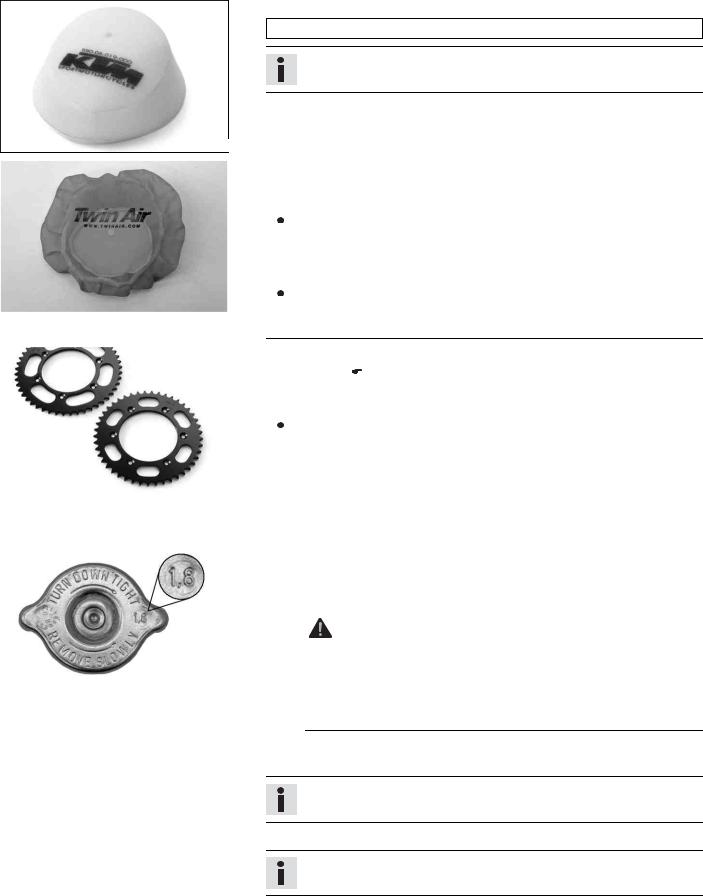
GENERAL TIPS AND HINTS ON PUTTING INTO OPERATION |
16 |
–Mount the dust cover for the air filter. Dust cover for air filter (59006019000)
Info
Follow the KTM PowerParts mounting instructions.
600869-01
|
|
– Mount the sand cover for the air filter. |
||||
|
|
|||||
|
|
|
|
|
|
|
|
|
|
Sand cover for air filter (59006022000) |
|||
|
|
|
|
|
|
|
|
|
|
|
|
|
|
|
|
|
|
|
|
Info |
|
|
|
|
|
|
|
|
|
|
|
|
|
Follow the KTM PowerParts mounting instructions. |
|
|
|
|
|||
|
|
– Adjust the carburetor jetting and setting. |
||||
|
|
|
|
|
|
|
|
|
|
|
|
|
Info |
|
|
|
|
|
|
|
|
600871-01 |
|
|
|
|
The recommended carburetor tuning is available from your authorized KTM |
|
|
|
|
|
|
|
|
|
|||||
|
|
|
|
|
|
workshop. |
|
|
– |
Clean the chain. |
|||
|
|
|||||
|
|
|
|
|
|
|
|
|
|
Chain cleaner ( p. 96) |
|||
|
|
|
|
|
|
|
|
|
– Mount the steel sprocket. |
||||
|
|
|
|
|
|
|
|
|
|
|
|
|
Tip |
|
|
|
|
|
|
|
|
|
|
|
|
|
Do not lubricate the chain. |
|
|
|
|
|||
|
|
– Clean the radiator fins. |
||||
|
|
– |
Carefully align bent radiator fins. |
|||
600868-01 |
||||||
Preparations6.5 |
for riding on wet sand |
|
|
|
|
|
|
|
|
|
– Check the radiator cap. |
|
|||
|
|
|
|
||||
|
|
|
|
|
|
|
|
|
|
|
|
Value on radiator cap |
1.8 bar (26 psi) |
||
|
|
|
|
|
|
|
|
|
|
|
|
» If the value displayed does not meet specifications: |
|||
|
|
|
|
|
|
|
|
|
|
|
|
|
|
Warning |
|
|
|
|
|
|
|
|
|
|
|
|
|
|
|
Danger of scalding During motorcycle operation, the coolant gets |
|
|
|
|
|
|
|
very hot and is under pressure. |
|
|
|
|
|
|
|
– Do not remove the radiator cap, radiator hoses or other cooling |
|
|
|
600872-10 |
|
|
|
system components when the engine is hot. Allow the engine |
|
|
|
|
|
|
|
and cooling system to cool down. In case of scalding, rinse |
|
|
|
|
|
|
|
immediately with lukewarm water. |
|
–Change the radiator cap.
–Seal the air filter box. x
Tip
Seal the air filter box at the edges to prevent dirt from entering.
–Clean the air filter. x( p. 63)
p. 63)
Info
Check the air filter approx. every 30 minutes.
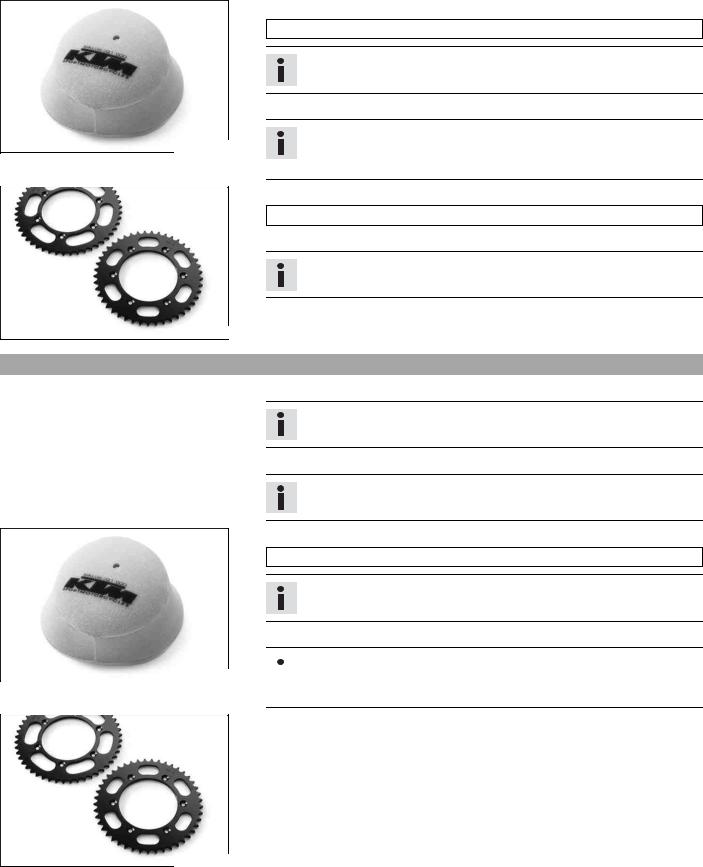
GENERAL TIPS AND HINTS ON PUTTING INTO OPERATION |
17 |
600870-01
600868-01
–Mount the rain cover for the air filter. Rain cover for air filter (59006021000)
Info
Follow the KTM PowerParts mounting instructions.
–Adjust the carburetor jetting and setting.
Info
The recommended carburetor tuning is available from your authorized KTM workshop.
–Clean the chain.
Chain cleaner ( p. 96)
p. 96)
–Mount the steel sprocket.
Tip
Do not lubricate the chain.
–Clean the radiator fins.
–Carefully align bent radiator fins.
Preparations6.6 for riding on wet and muddy surfaces
–Seal the air filter box. x
Tip
Seal the air filter box at the edges to prevent dirt from entering.
–Clean the air filter. x( p. 63)
p. 63)
Info
Check the air filter approx. every 30 minutes.
–Mount the rain cover for the air filter. Rain cover for air filter (59006021000)
Info
Follow the KTM PowerParts mounting instructions.
–Adjust the carburetor jetting and setting.
|
|
|
|
|
|
Info |
|
|
|
|
|
|
|
|
600870-01 |
|
|
|
|
The recommended carburetor tuning is available from your authorized KTM |
|
|
|
|
|
|
|
|
|
|||||
|
|
|
|
|
|
workshop. |
–Mount the steel sprocket.
–Clean the motorcycle. ( p. 74)
p. 74)
–Carefully align bent radiator fins.
600868-01
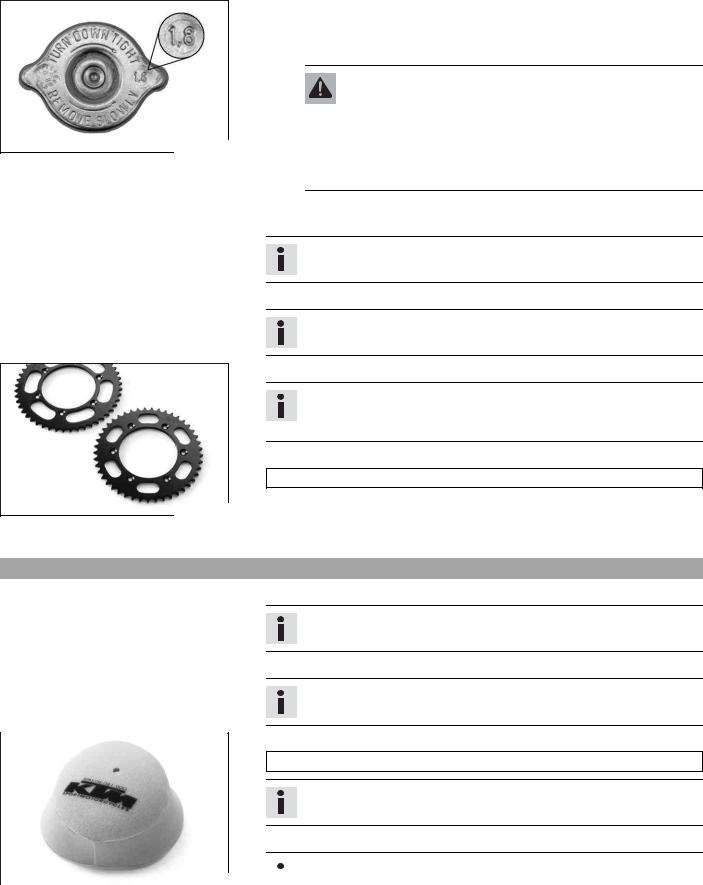
|
GENERAL TIPS AND HINTS ON PUTTING INTO OPERATION |
18 |
||
|
|
|
|
|
|
Preparations6.7 |
for riding at high temperatures and riding slowly |
|
|
600872-10
600868-01
–Check the radiator cap.
Value on radiator cap |
1.8 bar (26 psi) |
|
|
»If the value displayed does not meet specifications:
Warning
Danger of scalding During motorcycle operation, the coolant gets very hot and is under pressure.
–Do not remove the radiator cap, radiator hoses or other cooling system components when the engine is hot. Allow the engine and cooling system to cool down. In case of scalding, rinse immediately with lukewarm water.
–Change the radiator cap.
–Seal the air filter box. x
Tip
Seal the air filter box at the edges to prevent dirt from entering.
–Clean the air filter. x( p. 63)
p. 63)
Info
Check the air filter approx. every 30 minutes.
–Adjust the secondary ratio to the nature of the terrain.
Info
The engine oil heats up quickly if the clutch needs to be activated frequently because the secondary ratio is too long.
–Clean the chain.
Chain cleaner ( p. 96)
p. 96)
–Clean the radiator fins.
–Carefully align bent radiator fins.
–Check the coolant level. ( p. 59)
p. 59)
Preparations6.8 for riding at low temperatures and in snow
–Seal the air filter box. x
Tip
Seal the air filter box at the edges to prevent dirt from entering.
–Clean the air filter. x( p. 63)
p. 63)
Info
Check the air filter approx. every 30 minutes.
–Mount the rain cover for the air filter. Rain cover for air filter (59006021000)
Info
Follow the KTM PowerParts mounting instructions.
–Adjust the carburetor jetting and setting.
|
|
|
|
|
|
Info |
|
|
|
|
|
|
|
|
600870-01 |
|
|
|
|
The recommended carburetor tuning is available from your authorized KTM |
|
|
|
|
|
|
|
|
|
|
|
|
|
workshop. |
|
|
|
|
|
|
|
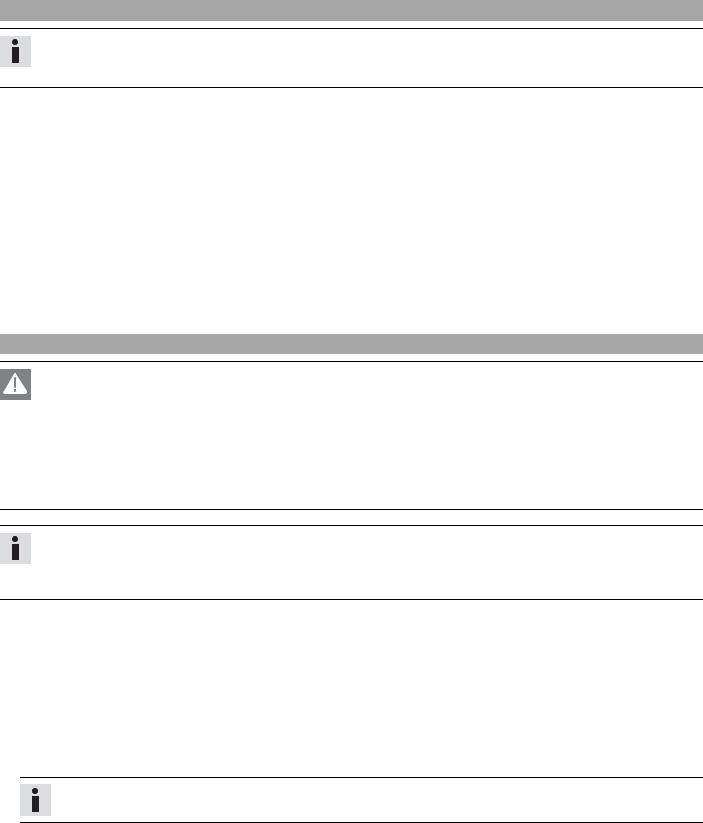
RIDING INSTRUCTIONS |
19 |
Checks7.1 before putting into operation
Info
Make sure that the motorcycle is in a perfect technical condition before use.
In the interests of riding safety, make a habit of making a general check before you ride.
–Check the gear oil level. ( p. 68)
p. 68)
–Check the chain tension. ( p. 40)
p. 40)
–Check the chain for dirt. ( p. 39)
p. 39)
–Check the tire condition. ( p. 53)
p. 53)
–Check the tire air pressure. ( p. 54)
p. 54)
–Check the front brake fluid level. ( p. 43)
p. 43)
–Check the rear brake fluid level. ( p. 47)
p. 47)
–Check the front brake linings. ( p. 44)
p. 44)
–Check the rear brake linings. ( p. 48)
p. 48)
–Check the brake system function.
–Check the coolant level. ( p. 59)
p. 59)
–Check the settings of all controls and ensure that they can be operated smoothly.
Starting7.2
Danger
Danger of poisoning Exhaust gases are poisonous and inhaling them may result in unconsciousness and/or death.
–When running the engine, always make sure there is sufficient ventilation, and do not start or run the engine in an enclosed space without an effective exhaust extraction system.
Note
Engine failure High engine speeds in cold engines have a negative effect on the service life of the engine.
–Always warm up the engine at low engine speeds.
Info
If the motorcycle is unwilling to start, the cause can be old fuel in the float chamber. The flammable elements of the fuel evaporate after a long time of standing.
If the float chamber is filled with fresh fuel, the engine starts immediately.
Engine has been out of use for more than one week
– Empty the carburetor float chamber. x( p. 68)
p. 68)
–Turn handle of the fuel tap to the ON position. (Figure B00003-10 p. 11)
p. 11)  Fuel can flow from the fuel tank to the carburetor.
Fuel can flow from the fuel tank to the carburetor.
–Remove the motorcycle from the stand.
–Shift gear to neutral.
The engine is cold
– Pull choke lever out as far as possible.
–Forcefully step on the kickstarter, pushing it all the way down.
Info
Do not open the throttle.
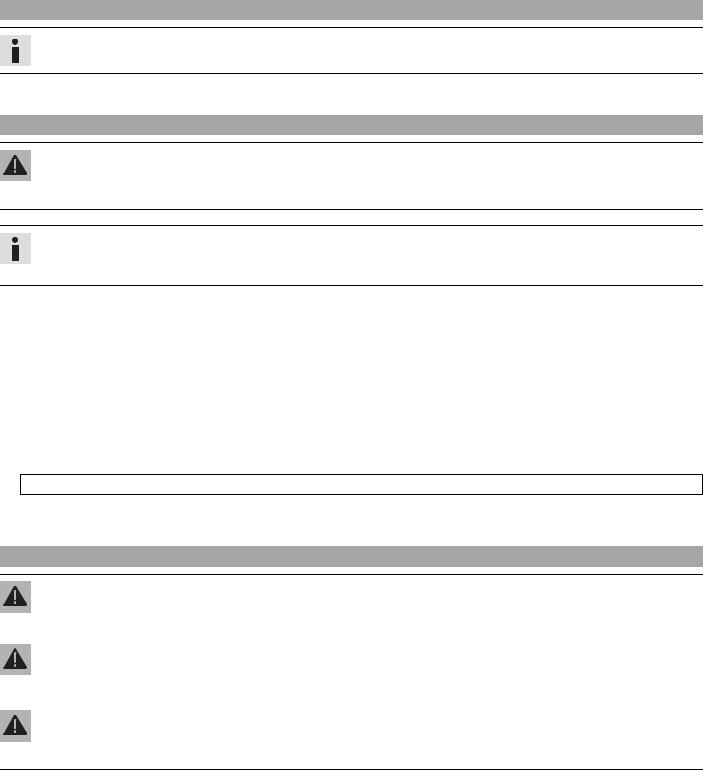
RIDING INSTRUCTIONS |
20 |
Starting7.3 up
Info
The plug-in stand must be removed before riding.
–Pull the clutch lever, engage 1st gear, release the clutch lever slowly and simultaneously open the throttle carefully.
Shifting,7.4 riding
Warning
Danger of accidents If you change down at high engine speed, the rear wheel can lock up.
–Do not change into a low gear at high engine speed. The engine overspeeds and the rear wheel can block.
Info
If you hear unusual noises while riding, stop immediately, switch off the engine and contact an authorized KTM workshop. First gear is used for starting off or for steep inclines.
–When conditions allow (incline, road situation, etc.), you can shift into a higher gear. To do so, release the throttle while simultaneously pulling the clutch lever, shift into the next gear, release the clutch and open the throttle.
–If the choke function was activated, deactivate it after the engine has warmed up.
–When you reach maximum speed after fully opening the throttle, turn back the throttle to about ¾ of its range. This barely reduces vehicle speed but lowers fuel consumption considerably.
–Always open the throttle only as much as the engine can handle – abrupt throttle opening increases fuel consumption.
–To shift down, brake and close the throttle at the same time.
–Pull the clutch lever and shift into a lower gear, release the clutch lever slowly and open the throttle or shift again.
–Switch off the engine if you expect to be standing for a long time. Guideline
≥2 min
–Avoid frequent and longer slipping of the clutch. This heats the engine oil, the engine and the cooling system.
–Ride with a lower engine speed instead of with a high engine speed and a slipping clutch.
Braking7.5
Warning
Danger of accidents If you brake too hard, the wheels can lock.
–Adapt your braking to the traffic situation and the road conditions.
Warning
Danger of accidents Reduced braking efficiency caused by spongy pressure point of front or rear brake.
–Check the brake system and do not continue riding. (Your authorized KTM workshop will be glad to help.)
Warning
Danger of accidents Reduced braking due to wet or dirty brakes.
–Clean or dry dirty or wet brakes by riding and braking gently.
–On sandy, wet or slippery surfaces, use the rear brake.
–Braking should always be completed before you go into a bend. Change down to a lower gear appropriate to your road speed.
–On long downhill stretches, use the braking effect of the engine. Change down one or two gears, but do not overstress the engine. In this way, you have to brake far less and the brakes do not overheat.

RIDING INSTRUCTIONS |
21 |
Stopping,7.6 parking
Warning
Risk of misappropriation Usage by unauthorized persons.
–Never leave the vehicle while the engine is running. Secure the vehicle against use by unauthorized persons.
Warning
Danger of burns Some vehicle components get very hot when the vehicle is in use.
–Do not touch hot components such as exhaust system, radiator, engine, shock absorber and brakes. Allow these components to cool down before starting work on them.
Note
Danger of damage The parked vehicle can roll away or fall over.
–Always place the vehicle on a firm and even surface.
Note
Fire hazard Some vehicle components become very hot when the vehicle is operated.
–Do not park the vehicle near flammable or explosive substances. Do not place objects on the vehicle while it is still warm from being run. Always let the vehicle cool first.
Note
Material damage Damage and destruction of components by excessive load.
–The side stand is designed for the weight of the motorcycle only. Do not sit on the motorcycle when it is supported by the side stand only. The side stand and/or the frame could be damaged and the motorcycle could fall over.
–Brake the motorcycle.
–Shift gear to neutral.
–Press and hold the short circuit button  while the engine is idling until the engine stops.
while the engine is idling until the engine stops.
–Turn handle of the fuel tap to the OFF position. (Figure B00003-10 p. 11)
p. 11)
–Insert the plug-in stand on the left side of the wheel spindle.
–Park the motorcycle on firm ground.
Refueling7.7
Danger
Fire hazard Fuel is highly flammable.
–Never refuel the vehicle near open flames or burning cigarettes, and always switch off the engine first. Be careful that no fuel is spilt, especially on hot vehicle components. Clean up spilt fuel immediately.
–Fuel in the fuel tank expands when warm and can escape if the tank is overfilled. See the notes on refueling.
Warning
Danger of poisoning Fuel is poisonous and a health hazard.
–Avoid contact of the fuel with skin, eyes and clothing. Do not inhale fuel vapors. If fuel gets into your eyes, rinse immediately with water and contact a doctor. Wash affected skin areas immediately with soap and water. If fuel is swallowed, contact a doctor immediately. Change clothing that has come into contact with fuel.
Warning
Environmental hazard Improper handling of fuel is a danger to the environment.
–Do not allow fuel to get into the ground water, the ground, or the sewage system.
–Switch off the engine.
–Open the filler cap. ( p. 11)
p. 11)

RIDING INSTRUCTIONS |
22 |
–Fill the fuel tank with fuel up to measurement . Guideline
|
|
|
|
|
|
|
Measurement of |
|
35 mm (1.38 in) |
|
|
|
|
|
|
|
|
|
|||
|
|
|
|
|
|
|
|
|
|
|
|
|
|
|
|
|
|
|
|
|
|
|
|
|
|
|
A |
|
Total fuel tank |
8 l (2.1 US gal) |
Super unleaded gasoline, mixed with |
|
|
|
|
|
|
||||||
|
|
|
|
|
|
|
capacity, approx. |
|
2-stroke engine oil (1:40) ( |
p. 95) |
|
|
|
|
|
|
|
||||
|
|
|
|
|
|
|
|
|
(125 SX, 150 SX) |
|
|
|
|
|
|
|
|
|
|
|
|
|
|
|
|
|
|
|
|
|
Super unleaded gasoline, mixed with |
|
|
|
|
|
|
|
|
|
|
2-stroke engine oil (1:60) ( |
p. 95) |
|
|
|
400382-10 |
|
|
|
(250 SX) |
|
||
|
|
|
|
|
|
|
|
|
|
|
–Close the filler cap. ( p. 11)
p. 11)

|
SERVICE SCHEDULE |
|
|
|
|
|
|
|
|
23 |
|||
|
|
|
|
|
|
|
|
||||||
|
Important8.1 |
maintenance work that must be done in an authorized KTM workshop |
|
|
|
|
|||||||
|
|
|
|
|
|
|
|
|
|
|
|
|
|
|
|
|
|
|
|
|
|
|
|
S10N |
S20A |
S40A |
|
|
|
|
|
|
|
|
|
|
|
|
|
||
|
Engine |
|
Check the gear oil level. ( |
p. 68) |
|
|
|
|
• |
• |
|
||
|
|
|
|
|
|
|
|
|
|
|
|
||
|
|
|
Change the gear oil. x( |
p. 69) |
|
|
|
• |
|
• |
|
||
|
|
|
Check spark plug and replace if required. x |
|
• |
• |
• |
|
|||||
|
|
|
Clean the spark plug connectors and check for tightness. x |
|
• |
• |
|
||||||
|
|
|
|
|
|
|
|
||||||
|
|
|
Check that the screws in the shift lever and the kickstarter are tight. |
• |
• |
• |
|
||||||
|
|
|
|
|
|
|
|
||||||
|
|
|
Check the engine mounting screws for tightness. |
• |
• |
• |
|
||||||
|
|
|
|
|
|
|
|
||||||
|
Carburetor |
|
Check intake flange and carburetor connection boot for cracks and leakage. |
• |
|
• |
|
||||||
|
|
|
|
|
|
|
|
|
|
|
|
|
|
|
|
|
Check idle. |
|
|
|
|
|
|
• |
|
• |
|
|
|
|
|
|
|
|
|
||||||
|
|
|
Check vent hoses for damage and routing without sharp bends. |
• |
|
• |
|
||||||
|
|
|
|
|
|
|
|
|
|||||
|
Attachments |
Check the cooling system for leakage. |
|
|
• |
|
• |
|
|||||
|
|
|
|
|
|
|
|
|
|||||
|
|
|
Check the antifreeze and coolant level. ( |
p. 58) |
• |
|
• |
|
|||||
|
|
|
|
|
|
|
|
||||||
|
|
|
Check the exhaust system for leakage and looseness. |
|
• |
• |
|
||||||
|
|
|
|
|
|
|
|
||||||
|
|
|
Check the cables for damage, smooth operation and routing without sharp bends. |
• |
• |
• |
|
||||||
|
|
|
|
|
|
|
|
|
|||||
|
|
|
Check the fluid level of the hydraulic clutch. ( |
p. 64) |
• |
• |
• |
|
|||||
|
|
|
|
|
|
|
|
|
|
|
|
||
|
|
|
Clean the air filter. x( |
p. 63) |
|
|
|
• |
• |
• |
|
||
|
|
|
Check the cables for damage and routing without sharp bends. |
• |
|
• |
|
||||||
|
|
|
|
|
|
|
|
|
|
|
|||
|
Brakes |
|
Check the front brake linings. ( |
p. 44) |
|
|
• |
|
• |
|
|||
|
|
|
|
|
|
|
|
|
|
|
|||
|
|
|
Check the rear brake linings. ( |
p. 48) |
|
|
• |
|
• |
|
|||
|
|
|
|
|
|
|
|
|
|
|
|
||
|
|
|
Check the brake discs. ( |
p. 42) |
|
|
|
• |
|
• |
|
||
|
|
|
|
|
|
|
|
|
|
||||
|
|
|
Check the front brake fluid level. ( |
p. 43) |
|
• |
• |
• |
|
||||
|
|
|
|
|
|
|
|
|
|
||||
|
|
|
Check the rear brake fluid level. ( |
p. 47) |
|
• |
• |
• |
|
||||
|
|
|
|
|
|
|
|
|
|||||
|
|
|
Check the brake lines for damage and leakage. |
|
• |
|
• |
|
|||||
|
|
|
|
|
|
|
|
|
|||||
|
|
|
Check the free travel of the hand brake lever. ( |
p. 43) |
• |
• |
• |
|
|||||
|
|
|
|
|
|
|
|
|
|||||
|
|
|
Check the free play of the foot brake lever. ( |
p. 46) |
• |
• |
• |
|
|||||
|
|
|
|
|
|
|
|
|
|
|
|||
|
|
|
Check the brake system function. |
|
|
|
• |
• |
• |
|
|||
|
|
|
|
|
|
|
|
||||||
|
|
|
Check the screws and guide bolts of the brake system for tightness. |
• |
• |
• |
|
||||||
|
|
|
|
|
|
|
|
||||||
|
Chassis |
|
Check the shock absorber and fork for leakage and functioning. x |
• |
• |
• |
|
||||||
|
|
|
|
|
|
|
|
|
|||||
|
|
|
Clean the dust boots of the fork legs. ( |
p. 32) |
• |
• |
• |
|
|||||
|
|
|
|
|
|
|
|
|
|
|
|
|
|
|
|
|
Bleed the fork legs. ( |
p. 32) |
|
|
|
|
• |
• |
• |
|
|
|
|
|
|
|
|
|
|
|
|
|
|
||
|
|
|
Check the swingarm bearing. |
|
|
|
|
• |
|
• |
|
||
|
|
|
|
|
|
|
|
|
|||||
|
|
|
Check the frame and swingarm for damage. |
|
• |
|
• |
|
|||||
|
|
|
|
|
|
|
|
|
|||||
|
|
|
Check the play of the steering head bearing. ( |
p. 33) |
• |
|
• |
|
|||||
|
|
|
|
|
|
|
|
|
|
||||
|
|
|
Check all screws to see if they are tight. |
|
|
• |
|
• |
|
||||
|
|
|
|
|
|
|
|
|
|
|
|
||
|
Wheels |
|
Check the spoke tension. ( |
p. 54) |
|
|
|
• |
• |
• |
|
||
|
|
|
|
|
|
|
|
|
|
|
|||
|
|
|
Check the wheel hubs for damage. |
|
|
|
• |
• |
• |
|
|||
|
|
|
|
|
|
|
|
|
|
|
|
|
|
|
|
|
Check rim run-out. |
|
|
|
|
|
|
• |
• |
• |
|
|
|
|
|
|
|
|
|
|
|
|
|
||
|
|
|
Check the tire condition. ( |
p. 53) |
|
|
|
• |
• |
• |
|
||
|
|
|
|
|
|
|
|
|
|
|
|||
|
|
|
Check the tire air pressure. ( |
p. 54) |
|
|
• |
• |
• |
|
|||
|
|
|
|
|
|
|
|
|
|
|
|
|
|
|
|
|
Check chain wear. ( |
p. 40) |
|
|
|
|
• |
• |
• |
|
|
|
|
|
|
|
|
|
|
|
|
|
|
||
|
|
|
Check the chain tension. ( |
p. 40) |
|
|
|
• |
• |
• |
|
||
|
|
|
|
|
|
|
|
|
|
|
|
|
|
|
|
|
Clean the chain. ( |
p. 39) |
|
|
|
|
• |
• |
• |
|
|
|
|
|
|
|
|
|
|
|
|
|
|||
|
|
|
Check the wheel bearing for play. |
|
|
|
• |
|
• |
|
|||
|
|
|
|
|
|
|
|
||||||
|
|
|
Clean and grease the adjusting screws of chain adjuster. |
• |
• |
• |
|
||||||
|
|
|
|
|
|
|
|||||||
|
S10N: Once after 10 service hours - corresponds to about 70 liters of fuel (18.5 US gal) |
|
|
|
|
||||||||
|
S20A: Every 20 service hours - corresponds to about 140 liters of fuel (37 US gal) |
|
|
|
|
||||||||
|
S40A: Every 40 service hours - corresponds to about 280 liters of fuel (74 US gal) / after a race |
|
|
|
|
||||||||
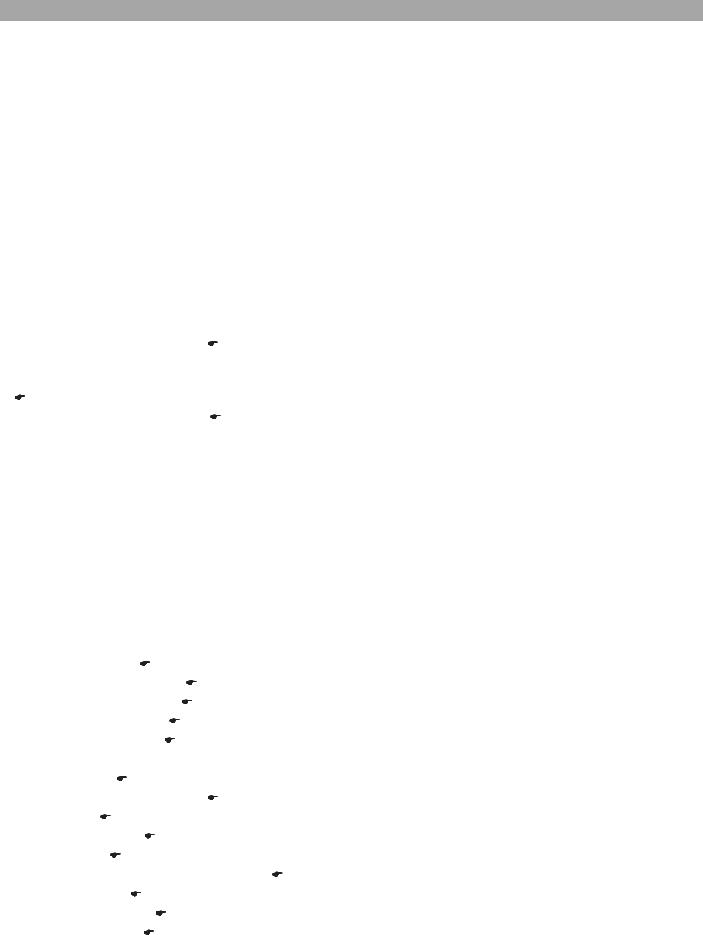
SERVICE SCHEDULE |
24 |
Important8.2 maintenance work to be carried out by an authorized KTM workshop (as additional order)
|
|
S10A |
S20N |
S20A |
S30A |
S40A |
S80A |
J1A |
|
|
|
|
|
|
|
|
|
Check/set the carburetor components. x |
|
|
|
|
|
|
• |
|
Check the intake diaphragm. x |
|
|
|
• |
|
• |
• |
|
|
|
|
|
|
|
|
|
|
Check the clutch lining discs. x |
|
|
|
• |
|
• |
• |
|
Check the length of the clutch springs. x |
|
|
• |
|
• |
• |
|
|
Check the cylinder and piston. x |
|
|
|
• |
|
• |
• |
|
|
|
|
|
|
|
|
|
|
Check the seating of the piston pin. x |
|
|
|
• |
|
• |
• |
|
Check exhaust control for functioning and smooth operation, |
|
|
• |
|
• |
• |
|
|
clean. x |
|
|
|
|
|
|||
|
|
|
|
|
|
|
|
|
Change the crankshaft main bearing. x |
|
|
|
|
|
|
• |
|
|
|
|
|
|
|
|
|
|
Change the conrod bearing. x |
|
|
|
|
|
• |
• |
|
Fully check the transmission. x |
|
|
|
|
|
• |
• |
|
Check the shift mechanism. x |
|
|
|
|
|
• |
• |
|
|
|
|
|
|
|
|
|
|
Conduct a major fork service. x |
|
|
|
|
• |
|
|
|
Conduct a minor fork service. x |
|
• |
|
• |
• |
• |
• |
|
Perform a shock absorber service. x |
|
|
• |
|
|
• |
• |
|
|
|
|
|
|
|
|
|
|
Grease the steering head bearing. x( |
p. 37) |
|
|
|
|
|
|
• |
Change the foot brake cylinder seals. x |
|
|
|
|
|
• |
• |
|
Change the glass fiber yarn filling of the main silencer. x |
|
|
• |
|
• |
• |
|
|
( p. 61) |
|
|
|
|
|
|||
|
|
|
|
|
|
|
|
|
|
|
|
|
|
|
|
|
|
Change the hydraulic clutch fluid. x( |
p. 65) |
|
|
|
|
|
|
• |
|
|
|
|
|
|
|
|
|
Change the front brake fluid. |
|
|
|
|
|
|
|
• |
|
|
|
|
|
|
|
|
|
Change the rear brake fluid. |
|
|
|
|
|
|
|
• |
|
|
|
|
|
|
|
|
|
Treat electric contacts with contact spray. |
|
|
|
|
|
|
• |
|
|
|
|
|
|
|
|
|
|
S10A: Every 10 service hours - corresponds to about 70 liters of fuel (18.5 US gal)
S20N: Once after 20 service hours - corresponds to about 140 liters of fuel (37 US gal)
S20A: Every 20 service hours - corresponds to about 140 liters of fuel (37 US gal)
S30A: Every 30 service hours - corresponds to about 210 liters of fuel (55.5 US gal)
S40A: Every 40 service hours - corresponds to about 280 liters of fuel (74 US gal)
S80A: Every 80 service hours - corresponds to about 560 liters of fuel (148 US gal)
J1A: annually
Important8.3 |
checks and maintenance work to be carried out by the rider |
|
||||
|
|
|
|
|
|
|
|
|
|
|
|
|
NB1A |
|
|
|
|
|||
Check the gear oil level. ( |
p. 68) |
|
• |
|||
|
|
|
||||
Check the front brake fluid level. ( |
p. 43) |
• |
||||
|
|
|
||||
Check the rear brake fluid level. ( |
p. 47) |
• |
||||
|
|
|
||||
Check the front brake linings. ( |
p. 44) |
• |
||||
|
|
|
||||
Check the rear brake linings. ( |
p. 48) |
• |
||||
|
|
|
|
|||
Check and adjust the cables. |
|
|
• |
|||
|
|
|
|
|
||
Bleed the fork legs. ( |
p. 32) |
|
|
• |
||
|
|
|||||
Clean the dust boots of the fork legs. ( p. 32) |
• |
|||||
|
|
|
|
|
|
|
Clean the chain. ( |
p. 39) |
|
|
|
• |
|
|
|
|
|
|||
Check the chain tension. ( |
p. 40) |
|
• |
|||
|
|
|
|
|
||
Check chain wear. ( |
p. 40) |
|
|
• |
||
|
|
|||||
Check the rear sprocket/engine sprocket for wear. ( p. 40) |
• |
|||||
|
|
|
||||
Clean the air filter. x( p. 63) |
|
• |
||||
|
|
|
|
|||
Check the tire air pressure. ( |
|
p. 54) |
• |
|||
|
|
|
|
|||
Check the tire condition. ( |
p. 53) |
|
• |
|||
|
|
|
|
|
|
|

|
SERVICE SCHEDULE |
25 |
|
|
|
|
|
|
|
NB1A |
|
|
|
|
|
|
Check the coolant level. ( p. 59) |
• |
|
|
|
|
|
|
Empty the carburetor float chamber. x( p. 68) |
• |
|
|
Check all controls for smooth operation. |
• |
|
|
|
|
|
|
Check braking. |
• |
|
|
|
|
|
|
Check all screws, nuts and hose clamps regularly for tightness. |
• |
|
|
|
|
|
|
NB1A: Depending on conditions of use according to requirements. |
|
|
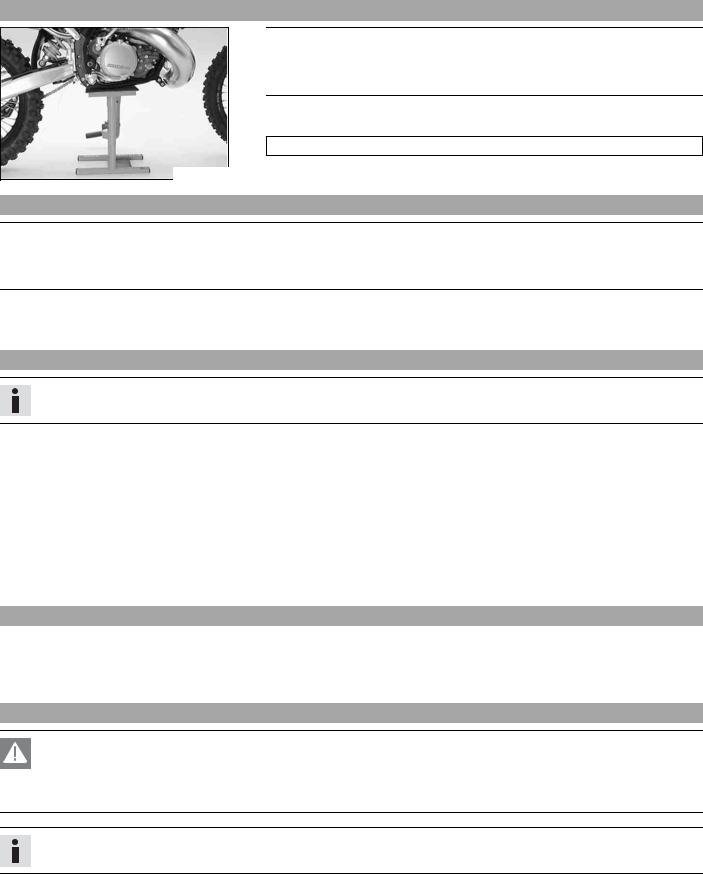
MAINTENANCE WORK ON CHASSIS AND ENGINE |
26 |
Jacking9.1 up the motorcycle
B00011-10
Note
Danger of damage The parked vehicle can roll away or fall over.
– Always place the vehicle on a firm and even surface.
–Jack up the motorcycle underneath the engine. The wheels must no longer touch the ground.
Work stand (54829055000)
–Secure the motorcycle against falling over.
Removing9.2 the motorcycle from the work stand
Note
Danger of damage The parked vehicle can roll away or fall over.
–Always place the vehicle on a firm and even surface.
–Remove the motorcycle from the work stand.
–Remove the work stand.
Checking9.3 the basic chassis setting with the rider's weight
Info
When adjusting the basic chassis setting, first adjust the shock absorber and then the fork.
–For optimal motorcycle riding characteristics and to avoid damage to forks, shock absorbers, swing arm and frame, the basic settings of the suspension components must match your body weight.
–As delivered, KTM offroad motorcycles are adjusted for a standard rider weight (with full protective clothing). Guideline
Standard rider weight |
75… 85 kg (165… 187 lb.) |
|
|
–If your weight is above or below the standard range, you need to adjust the basic setting of the suspension components accordingly.
–Small weight differences can be compensated by adjusting the spring preload, but in the case of large weight differences, the springs must be replaced.
Compression9.4 damping of shock absorber
The shock absorber can separately regulate compression damping in the lowand high-speed ranges (Dual Compression Control). Here, low-speed and high-speed refer to the movement of the shock absorber during compression and not the riding speed of the motorcycle.
Changes in the settings in the low-speed range have an impact on the high-speed range and vice versa.
Adjusting9.5 the high-speed compression damping of the shock absorber
Danger
Danger of accidents Disassembly of pressurized parts can lead to injury.
–The shock absorber is filled with high density nitrogen. Adhere to the description provided. (Your authorized KTM workshop will be glad to help.)
Info
The high-speed setting can be seen during the fast compression of the shock absorber.

MAINTENANCE WORK ON CHASSIS AND ENGINE |
27 |
–Turn adjusting screw all the way clockwise with a ring wrench.
Info
Do not loosen nut !
–Turn back counterclockwise by the number of turns corresponding to the shock absorber type.
Guideline
(125 SX, 150 SX)
|
400208-10 |
|
|
Compression damping, high-speed |
|
|
|
|
|
|
|
|
|
|
|
Comfort |
2 turns |
|
|
|
|
|
|
|
|
|
|
Standard |
1.5 turns |
|
|
|
|
|
|
|
|
|
|
Sport |
1 turn |
|
|
|
|
|
|
|
|
|
(250 SX) |
|
|
|
|
|
|
|
|
|
|
|
|
Compression damping, high-speed |
|
|
|
|
|
|
|
|
|
|
|
Comfort |
2 turns |
|
|
|
|
|
|
|
|
|
|
Standard |
1.5 turns |
|
|
|
|
|
|
|
|
|
|
Sport |
1 turn |
|
|
|
|
|
|
|
|
|
|
|
|
Info
Turn clockwise to increase damping, turn counterclockwise to reduce damping.
Adjusting9.6 the low-speed compression damping of the shock absorber
Danger
Danger of accidents Disassembly of pressurized parts can lead to injury.
–The shock absorber is filled with high density nitrogen. Adhere to the description provided. (Your authorized KTM workshop will be glad to help.)
Info
The low-speed setting can be seen during the slow to normal compression of the shock absorber.
–Turn adjusting screw clockwise with a screwdriver up to the last perceptible click.
Info
Do not loosen nut !
–Turn back counterclockwise by the number of clicks corresponding to the shock absorber type.
Guideline
|
|
|
(125 SX, 150 SX) |
|
|
|
400209-10 |
|
|||
|
|
|
|
|
|
|
|
|
|
Compression damping, low-speed |
|
|
|
|
|
|
|
|
|
|
|
Comfort |
17 clicks |
|
|
|
|
|
|
|
|
|
|
Standard |
15 clicks |
|
|
|
|
|
|
|
|
|
|
Sport |
13 clicks |
|
|
|
|
|
|
|
|
|
(250 SX) |
|
|
|
|
|
|
|
|
|
|
|
|
Compression damping, low-speed |
|
|
|
|
|
|
|
|
|
|
|
Comfort |
17 clicks |
|
|
|
|
|
|
|
|
|
|
Standard |
15 clicks |
|
|
|
|
|
|
|
|
|
|
Sport |
13 clicks |
|
|
|
|
|
|
|
|
|
|
|
|
Info
Turn clockwise to increase damping, turn counterclockwise to reduce damping.
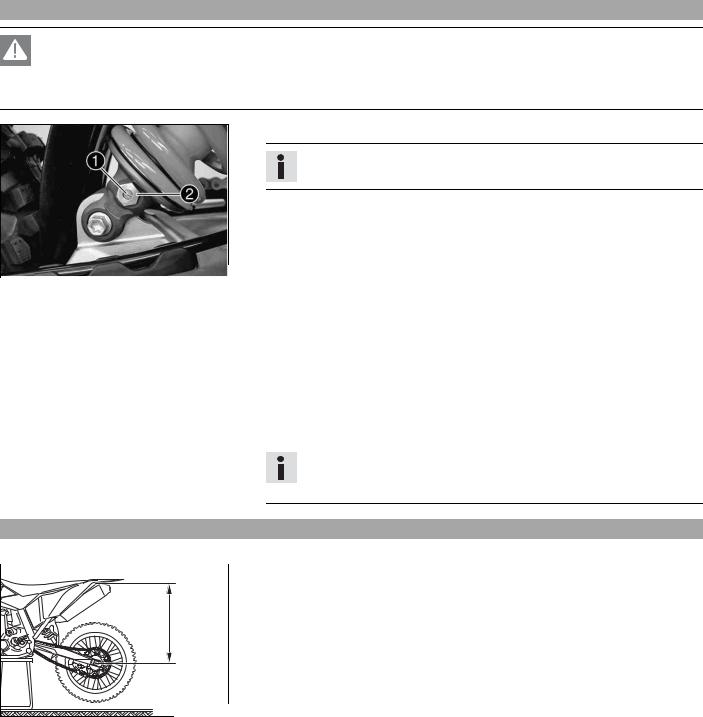
MAINTENANCE WORK ON CHASSIS AND ENGINE |
28 |
Adjusting9.7 the rebound damping of the shock absorber
Danger
Danger of accidents Disassembly of pressurized parts can lead to injury.
–The shock absorber is filled with high density nitrogen. Adhere to the description provided. (Your authorized KTM workshop will be glad to help.)
–Turn adjusting screw clockwise up to the last perceptible click.
Info
Do not loosen nut !
–Turn back counterclockwise by the number of clicks corresponding to the shock absorber type.
Guideline
(125 SX, 150 SX)
|
|
|
|
Rebound damping |
|
400210-10 |
|
||||
|
|
|
|
|
|
|
|
|
|
Comfort |
24 clicks |
|
|
|
|
|
|
|
|
|
|
Standard |
22 clicks |
|
|
|
|
|
|
|
|
|
|
Sport |
22 clicks |
|
|
|
|
|
|
|
|
|
(250 SX) |
|
|
|
|
|
|
|
|
|
|
|
|
Rebound damping |
|
|
|
|
|
|
|
|
|
|
|
Comfort |
24 clicks |
|
|
|
|
|
|
|
|
|
|
Standard |
22 clicks |
|
|
|
|
|
|
|
|
|
|
Sport |
22 clicks |
|
|
|
|
|
|
|
|
|
|
|
|
Info
Turn clockwise to increase damping, turn counterclockwise to reduce damping.
Measuring9.8 the sag of the unloaded rear wheel
0A |
400220-10 |
–Jack up the motorcycle. ( p. 26)
p. 26)
–Measure the distance – as vertical as possible – between the rear axle and a fixed point, for example, a mark on the side cover.
–Make a note of the value as measurement .
–Remove the motorcycle from the work stand. ( p. 26)
p. 26)
